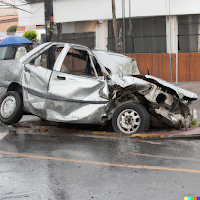Primary victims on El Salvador's roads are pedestrians and motorcyclists
Last Tuesday, three traffic accidents in different parts of El Salvador provided graphic examples of some of the issues involving traffic management in El Salvador. Two involved the deaths of motorcycle riders who perished when they were struck by other vehicles on Salvadoran highways. The third was a massive pile up in the capital city San Salvador when a large trailer truck careened in what appeared to be uncontrolled speed into stopped traffic at a point where major thoroughfares come together. Two people were killed and at least ten injured, many in critical condition. Dozens of cars were left destroyed by the pile-up.
Road fatalities are an ongoing concern in El Salvador. With an annual death rate of around 22 fatalities per 100,000 inhabitants, the country faces a significant challenge in reducing the number of lives lost due to traffic accidents. Many factors contribute to this situation including inadequate infrastructure, poorly maintained roads, insufficient traffic law enforcement, and a general lack of road safety awareness among drivers and pedestrians.
The death rate on El Salvador's roads is higher than global averages. In 2019, El Salvador's rate of traffic fatalities was 22.2 per 100,000 in population, while the rate for all Latin America was 17.0 and the worldwide average rate was 15.0 according to Our World in Data.
In fact, for the past two years, more people died in traffic accidents in El Salvador than were killed in criminal violence as the homicide rate has dropped but traffic deaths remain stubbornly high.
The recent data does show some slight improvement. The daily average number of deaths declined from a high of 3.9 in 2019 to 3.7 in 2021 and 2022. So far in 2023, despite last Tuesday's accidents, the average has been 3.4, with about 10% fewer deaths than in the same period last year.
What has declined significantly, however, is the rate of deaths expressed in comparison to the number of vehicles. In 2015, the rate was 12.4 for every 10,000 vehicles, but by 2022 the rate had dropped by more than a third to to 8.4 per 10,000 vehicles on the road. The number of registered vehicles has grown steadily, but the number of road deaths has not increased at the same rate, and in fact is modestly declining.
Unfortunately, civilians bear the brunt of traffic fatalities in El Salvador. Pedestrians, bicyclists, and motorcyclists are particularly vulnerable, as they are frequently involved in accidents caused by poor road conditions, speeding, or reckless driving. The loss of life and the economic impact on families and communities cannot be understated.
In 2022, the largest grouping of victims in traffic were pedestrians, who made up 41% of the deaths followed by motorcycle riders at 32%.
El Salvador's rapidly growing number of vehicles on the roads and concentration of economic activity in urban areas have put immense pressure on the existing transportation infrastructure. San Salvador is a prime example of this issue, as it has experienced an unprecedented surge in traffic volumes. The lack of efficient public transportation systems and the rising number of private vehicles have led to frequent gridlocks, hampering the quality of life and economic productivity in the country. The stress of spending hours in traffic affects everyone.
The number of vehicles on the roads has increased between 8.5 and 8.9% in all but one of the last 7 years. Just in 2021 and 2022, El Salvador added 143,000 vehicles to its roads. You can read my traffic report piece from May 2022 about some of the costs of this congestion.
- Driver Distraction 4,140
- Invading Traffic Lane 3,758
- Not Respecting Traffic Signals 2,580
- Not Maintaining Regulatory Distance 2,386
- Excessive Speed 1,537
- Backing Up 696
- Illegal Overtaking 583
- Driving Under the Influence of Alcohol or Drugs 514
- Inexperience 349
- Incorrect Turning 251
In January the Legislative Assembly addressed traffic problems by passing a law that significantly increases the fines for traffic violations and which permits the use of ticketing by technology such as stop light cameras. It's not clear how much just increasing fines will help, since the bigger problem seems to be the lack of enforcement of the existing laws and sanctions.
Seeking Solutions:
To address these pressing issues, the government and relevant stakeholders will need to work together to implement comprehensive solutions. Some strategies to consider include:
- Developing and expanding public transportation systems: By offering affordable, reliable, and efficient alternatives to private vehicles, public transportation can help reduce congestion and minimize the number of accidents on the roads. Unfortunately, there have been few announcements of initiatives in this space at the national or municipal level. The country's one foray into an improved system, SITRAMSS, is abandoned and unused and a cautionary tale for future planners.
- Improving road infrastructure and maintenance: Investing in well-designed, well-maintained roads with appropriate safety features can significantly reduce the risk of accidents and fatalities.
- Strengthening traffic law enforcement: A greater emphasis on enforcing traffic regulations, including speed limits, can deter reckless driving and promote safer road conditions.
- Enhancing road safety education: Raising awareness about road safety and responsible driving practices through public campaigns and educational initiatives can lead to better-informed drivers and pedestrians, ultimately reducing the number of fatalities.
All the data about traffic in El Salvador in this article was taken from the website of the National Road Safety Observatory of the government of El Salvador, where you can drill down even deeper into this data.
From the Observatory, here is the timeline of traffic deaths in January 2023. All of us want to see more days with zero deaths.






Comments